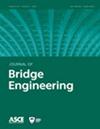17.8 mm (0.7 in.)预应力梁的性能评价链
IF 3.5
2区 工程技术
Q2 ENGINEERING, CIVIL
引用次数: 0
摘要
人们越来越感兴趣的是使用大直径钢绞线,通过使用更少的钢绞线来缓解拥堵,通过增加梁间距来减少梁的总数,增加跨度长度,并允许较浅的梁。虽然2020 AASHTO LRFD桥梁设计规范参考了AASHTO M203,包括17.8毫米(0.7英寸)的钢绞线,但这些更大直径的钢绞线没有用于桥梁建设,主要是因为AASHTO LRFD对用17.8毫米(0.7英寸)钢绞线加固的构件的设计方面保持沉默。所呈现的多方面,多年的研究包括广泛的参数化设计案例研究,非线性有限元分析,材料表征,组件测试和全尺寸梁实验。本文侧重于全尺寸梁试验,用于检查开发长度,详细要求,弯曲和剪切行为和强度。实验确定的开发长度比AASHTO LRFD规范规定的要短。弯曲和剪切强度可以用既定的程序来确定。目前所要求的最小约束钢筋量足以约束17.8毫米(0.7英寸)的钢绞线。对于有17.8毫米(0.7英寸)部分脱粘的钢绞线,底部法兰约束钢筋的延伸是不够的,但是对于没有脱粘的钢绞线,底部法兰约束钢筋延伸到超过梁端1.5d是足够的。AASHTO LRFD规范要求的最小底部法兰约束加强必须延长至至少1.5d,超过最长脱粘长度17.8 mm (0.7 in.)链的终止。本文章由计算机程序翻译,如有差异,请以英文原文为准。
Performance Evaluation of Prestressed Girders with 17.8-mm (0.7-in.) Strands
There has been a growing interest in using large-diameter strands to alleviate congestion by using fewer strands, reduce the total number of girders by increasing girder spacing, increase the span length, and allow shallower girders. While the 2020 AASHTO LRFD Bridge Design Specifications included 17.8-mm (0.7-in.) strands by reference to AASHTO M203, these larger-diameter strands were not used in bridge construction primarily because AASHTO LRFD was silent about the design aspects of members reinforced with 17.8-mm (0.7-in.) strands. The presented multifaceted, multiyear research involved an extensive parametric design case study, nonlinear finite-element analyses, material characterization, component tests, and full-scale girder experiments. This paper focuses on the full-scale girder tests, which were used to examine development length, detailing requirements, and flexural and shear behavior and strength. Experimentally determined development lengths were found to be shorter than those prescribed by the AASHTO LRFD Specification. Flexural and shear strength could be determined using established procedures. The current minimum required amount of confinement reinforcement was found to be sufficient to confine 17.8-mm (0.7-in.) strands. The extension of bottom flange confinement reinforcement was found to be inadequate for cases with partially debonded 17.8-mm (0.7-in.) strands, but extension of bottom flange confinement reinforcement to 1.5d beyond the end of the girder was adequate for cases with no debonded strands. The minimum bottom flange confinement reinforcement required by the AASHTO LRFD Specification must be extended to at least 1.5d beyond the termination of the longest debonded length of 17.8-mm (0.7-in.) strands.
求助全文
通过发布文献求助,成功后即可免费获取论文全文。
去求助
来源期刊

Journal of Bridge Engineering
工程技术-工程:土木
CiteScore
6.30
自引率
5.60%
发文量
166
审稿时长
6 months
期刊介绍:
The Journal of Bridge Engineering publishes papers about all aspects of the art and science of bridge engineering. The journal publishes research that advances the practice and profession of bridge engineering and papers about issues, projects, materials, design, fabrication, construction, inspection, evaluation, safety, performance, management, retrofitting, rehabilitation, repair, and demolition.
 求助内容:
求助内容: 应助结果提醒方式:
应助结果提醒方式:


